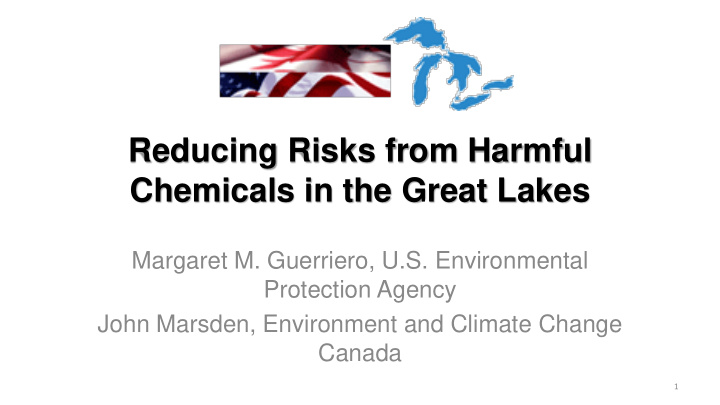



Reducing Risks from Harmful Chemicals in the Great Lakes Margaret M. Guerriero, U.S. Environmental Protection Agency John Marsden, Environment and Climate Change Canada 1
Chemicals Annex Purpose Protect human health and the environment through cooperative and coordinated measures to reduce the anthropogenic release of chemicals of mutual concern into the Waters of the Great Lakes 2
The Great Lakes are Important • A wealth of natural resources to the citizens of Canada and the U.S. • Supports a higher population density and concentration of industrial activity than many other regions: • Industry • Agriculture • Recreation • Drinking Water 3
Chemicals Continue to Impact the Lakes Higher population density and industrial activity have brought increased risks from chemical pollution • Certain toxic chemicals can • Potentially harm aquatic ecosystems • Be persistent and accumulate within the food web • Disproportionately affect susceptible subpopulations 4
Canada and the U.S. Continue to Cooperate to Address Great Lakes Chemical Pollution • Impacts to wildlife were common due to toxic chemicals • The 1987 Great Lakes Water Quality Agreement listed target chemicals for action • Decreases in production, use and discharge of chemicals – domestic legislation and programs – coordinated regional and binational activities 5
We Have Reduced Chemical Pollution Temporal changes from the Great Lakes (1976 – 2014) (USEPA & ECCC) Mercury concentrations in Water (ECCC) 6
Chemical Pollution Remains a Significant Issue • Annex 3 – Chemicals of Mutual Concern – Address chemical pollution still present – Led by Canada (ECCC) and the United States (EPA) – Other federal (national and regional) provincial, state, tribal/First Nation Pukaskwa National Park, Ontario and local programs and initiatives Source: Darren McChristie 7
We are Taking Action on Chemicals Topic GLWQA Annex 3 Commitments Develop and implement a dynamic and science-based process to identify Identifying Chemicals of and designate CMCs on an ongoing basis Mutual Concern (CMCs) Develop and implement binational strategies for CMCs, which may include research, monitoring, surveillance, the development of water quality Binational Strategies standards, criteria, objectives or guidelines and pollution prevention and/or other risk management actions Deliver science activities, as identified in binational strategies for CMCs, in Science order to provide ‘early-warning’, through research and surveillance, for chemicals which could become CMCs Regularly exchange information on monitoring, surveillance, research, Information technology and measures for managing CMCs Report on progress toward Annex implementation every three years, Reporting through the Progress Report of the Parties 8
Coordination and collaboration with partners and stakeholders is critical • In meeting commitments, we engage and work with many government partners and non-government stakeholders Government Other Partners Ontario Ministry of Environment and Climate Canadian Environmental Law Association Change National Wildlife Federation Indiana Department of Environmental Great Lakes Green Chemistry Network Management Council of Great Lakes Industries Minnesota Department of Health Chemical Industry Association of Canada Wisconsin Department of Natural Resources Pollution Probe Great Lakes Indian Fish and Wildlife International Joint Commission Commission 9
Eight Chemicals of Mutual Concern Designated • Mercury • Polychlorinated biphenyls (PCBs) • Perfluorooctane sulfonate (PFOS) • Perfluorooctanoic acid (PFOA) • Long-chain perfluorinated • Polybrominated diphenyl ethers carboxylic acids (LC-PFCAs) (PBDEs) • Hexabromocyclododecane (HBCD) • Short-chain chlorinated paraffins (SCCPs) 10
We have taken Binational Actions on Chemical Pollution in the Great Lakes (2014 – 2016) • Launched CMC nomination process • Conducted monitoring and/or surveillance for chemicals – Existing programs – Cooperative Science and Monitoring Initiative • Initiated Binational Strategies – Begin with Polychlorinated Biphenyls (PCBs) and Hexabromocyclododecane (HBCD) – Remaining strategies in 2017 11
U.S. Actions on Chemical Pollution in the Great Lakes (2014 – 2016) • Monitoring and Surveillance • Funded research through Great Lakes Restoration Initiative • Coordinated efforts through Toxic Substances Control Act • Binational Strategies 12
Canadian Actions on Chemical Pollution in the Great Lakes (2014 – 2016) • National Chemicals Management Plan (CMP) • Risk management for CMCs under the Canadian Environmental Protection Act, 1999, for example : – The Polychlorinated Biphenyl Regulations; – The Prohibition of Certain Toxic Substance Regulations; – The Products Containing Mercury Regulations; • Federal Environmental Quality Guidelines • Monitoring and Surveillance (national and regional) 13
Moving Forward: Binational Priorities for Science and Action Action Priorities • Continue the development of Binational Strategies • Identify and assess additional CMCs (Radionuclides) Science Priorities • Continue research, monitoring and/or surveillance activities • Coordinate efforts to provide an early warning system 14
You can get more information at www.binational.net 15
Recommend
More recommend